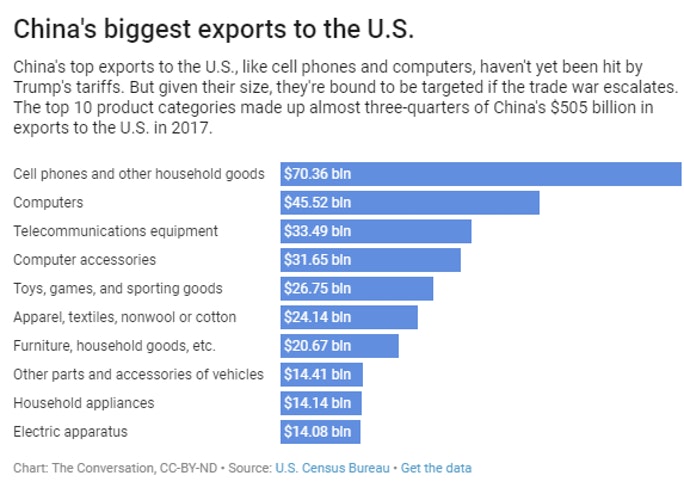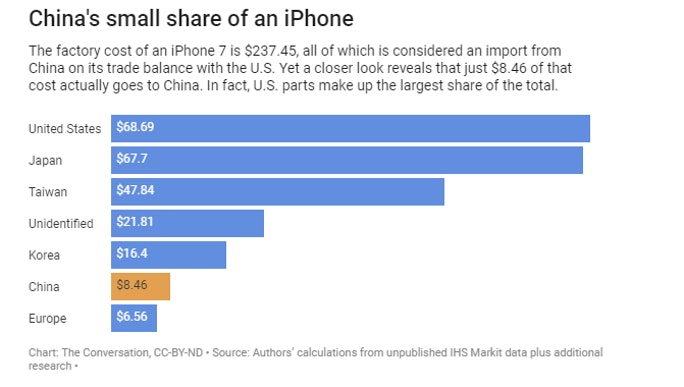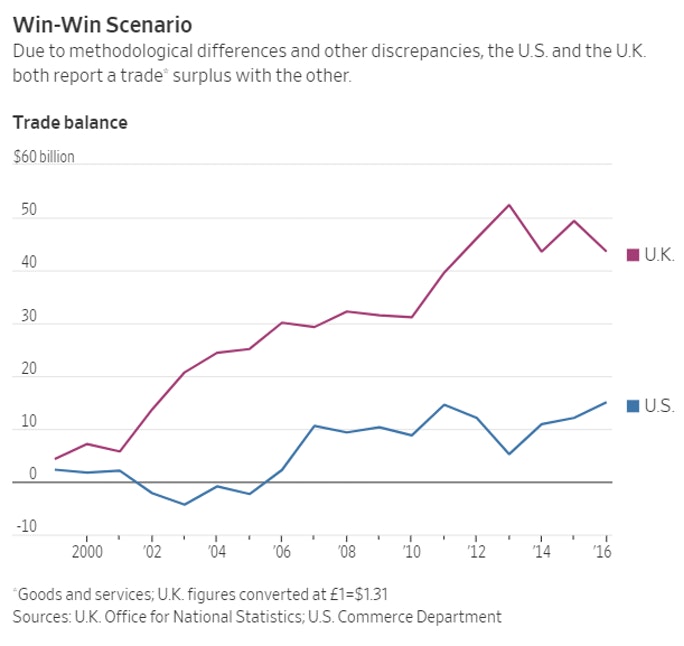Trump's trade thesis with China misses the boat. The iPhone provides an excellent starting point for discussion.
Supply Chain Analysis
As trade barriers break up, world-wide supply chains, the real costs are higher prices and fewer choices for consumers says Greg IP, my favorite WSJ author.
Globalization in Reverse
Please consider That Noise You Hear Is the Sound of Globalization Going Into Reverse by Greg Ip. I reordered some paragraphs below.
While globalization is routinely portrayed as bad for U.S. workers, the truth is more subtle. Routine, blue-collar jobs do get outsourced but high-end research, marketing and design work gravitates to the U.S.
Canadian steel uses iron ore from Minnesota, so Mr. Trump’s tariffs hurt both. About 17% of the value of Mexican-made cars exported to the U.S. originated in the U.S., according to Bruegel, a Brussels-based think tank.
Beckett Gas Inc., family-owned manufacturer of components for boilers, furnaces and water heaters, has over the years shifted production from abroad to its Cleveland-area factories. By continuously improving its production process, it has avoided price increases and now sells all over the world.
But that arrangement has been endangered by the 25% tariff on imported steel, the dominant input into Beckett’s products. “There are only foreign competitors to what we do,” Morrison Carter, the company’s chief executive, says. Those competitors now have a 25% cost advantage.
Assembling an iPhone entirely in the U.S. out of American-made components would add up to $100 to its cost, according to a 2016 article in MIT Technology Review. This assumes, of course, Apple successfully relocates its supply chain. When, under pressure from the Obama administration, it began assembling computers in Austin, Texas, it encountered numerous quality-control and workforce headaches.
Of course, supply chains that took years to take shape won’t change location overnight. Businesses still hope the protectionist wave burns itself out, and the logic of globalization reasserts itself. But a growing number are no doubt drawing up backup plans that look a lot like Harley’s.
Spotlight iPhone
The Conversation reports We estimate China only makes $8.46 from an iPhone – and that’s why Trump’s trade war is futile.
When an iPhone arrives in the U.S., it is recorded as an import at its factory cost of about $240, which is added to the massive U.S.-China bilateral trade deficit.
IPhone imports look like a big loss to the U.S., at least to the president, who argues that “China has been taking out $500 billion a year out of our country and rebuilding China.” One estimate suggests that imports of the iPhone 7 and 7 Plus contributed $15.7 billionto last year’s trade deficit with China.
But, as our research on the breakdown of an iPhone’s costs show, this number does not reflect the reality of how much value China actually gets from its iPhone exports – or from many of the brand-name electronics goods it ships to the U.S. and elsewhere. Thanks to the globe-spanning supply chains that run through China, trade deficits in the modern economy are not always what they seem.
China's Biggest Exports

Who Really Makes the iPhone?
Start with the most valuable components that make up an iPhone: the touch screen display, memory chips, microprocessors and so on. They come from a mix of U.S., Japanese, Korean and Taiwanese companies, such as Intel, Sony, Samsung and Foxconn. Almost none of them are manufactured in China. Apple buys the components and has them shipped to China; then they leave China inside an iPhone.
So what about all of those famous factories in China with millions of workers making iPhones? The companies that own those factories, including Foxconn, are all based in Taiwan. Of the factory-cost estimate of $237.45 from IHS Markit at the time the iPhone 7 was released in late 2016, we calculate that all that’s earned in China is about $8.46, or 3.6 percent of the total. That includes a battery supplied by a Chinese company and the labor used for assembly.
The other $228.99 goes elsewhere.

That's it. Of the $237.45 attributed to China as an import, China gets $8.46. The result is US imports from China are overstated by $15- to $16-billion on the iPhone alone.
The Conversation concludes:
Trump’s trade war is based on a simplistic understanding of the trade balance. Expanding tariffs to more and more goods will weigh on U.S. consumers, workers and businesses. And there’s no guarantee that the final outcome will be good when the dispute ends.
This is a war that should never have been started.
Trade and Supply Chain Math
Trump understands neither trade nor supply chain math.
The US is a huge beneficiary of China's role in assembling the iPhone. As per Greg Ip's article, the US benefits greatly from auto manufacturing in Mexico.
Trade Math Gone Haywire
In Trump Reverses Course, Promises "Great Trade Deal" With UK I posted this amusing chart.

The US and and UK both claim to have a trade surplus with each other. Of course, that is impossible. And it highlights how silly these discussions are. I offered this "perfect solution".
Perfect Solution
Change the methodology such that trade surpluses and deficits cease to exist anywhere. If anyone can do that, Trump surely can.
My sarcastic comment aside, Trump's trade math is wrong on numerous fronts. Yet, even if corrected, the US will still have a deficit.
So what?
Make Trade Math Great Again
As I suggested, let's revise the math to make it work, declare victory, and praise Trump for his brilliance (which is all his ego demands anyway). Then we can stop the trade war madness.
Make trade math great again. That's all it takes.
This material is based upon information that Sitka Pacific Capital Management considers reliable and endeavors to keep current, Sitka Pacific Capital Management does not assure that this material is accurate, current or complete, and it should not be relied upon as such.
Recommended Content
Editors’ Picks
EUR/USD clings to daily gains above 1.0650

EUR/USD gained traction and turned positive on the day above 1.0650. The improvement seen in risk mood following the earlier flight to safety weighs on the US Dollar ahead of the weekend and helps the pair push higher.
GBP/USD recovers toward 1.2450 after UK Retail Sales data

GBP/USD reversed its direction and advanced to the 1.2450 area after touching a fresh multi-month low below 1.2400 in the Asian session. The positive shift seen in risk mood on easing fears over a deepening Iran-Israel conflict supports the pair.
Gold holds steady at around $2,380 following earlier spike

Gold stabilized near $2,380 after spiking above $2,400 with the immediate reaction to reports of Israel striking Iran. Meanwhile, the pullback seen in the US Treasury bond yields helps XAU/USD hold its ground.
Bitcoin Weekly Forecast: BTC post-halving rally could be partially priced in Premium

Bitcoin price shows no signs of directional bias while it holds above $60,000. The fourth BTC halving is partially priced in, according to Deutsche Bank’s research.
Week ahead – US GDP and BoJ decision on top of next week’s agenda

US GDP, core PCE and PMIs the next tests for the Dollar. Investors await BoJ for guidance about next rate hike. EU and UK PMIs, as well as Australian CPIs also on tap.